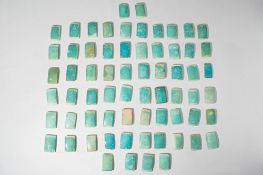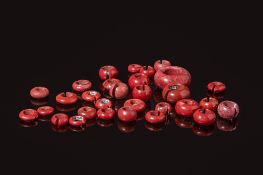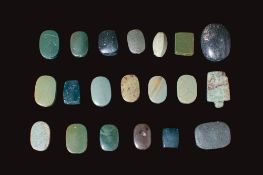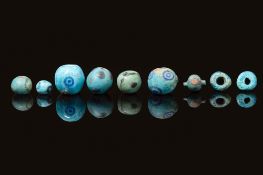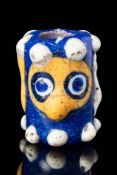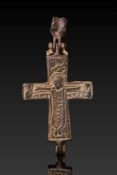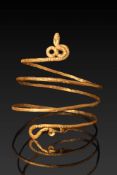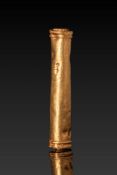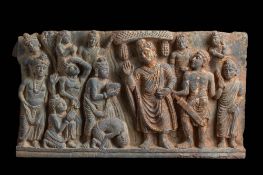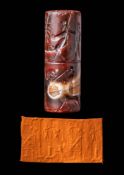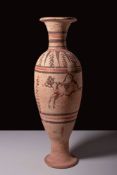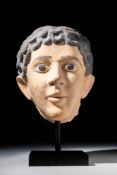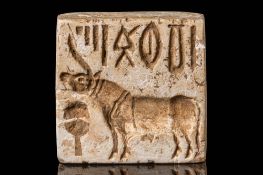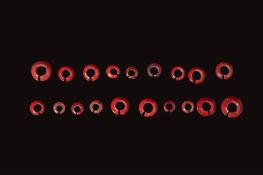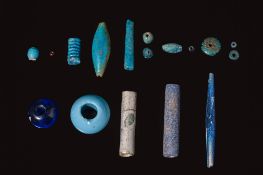Ca. AD 1 - 200. A gold ring with a broad, tapering hoop and a rounded bezel set with a polished garnet cabochon in a recessed circular cell. For ...
*
Sortieren nach:
- Auktionshaus
- Liste
- Galerie
-
909 Los(e)/Seite
Old Kingdom, Ca. 2686 - 2181 BC. A collection of 66 rectangular faience tiles, each with a slightly convex upper face, coated in a turquoise glaz...
Ca. AD 1 - 200. A red intaglio engraved with the figure of Diana standing in profile to the left, holding a bow and quiver. She leans against a c...
Ca. AD 800 - 900. A pale greenish-blue glass bottle with a flattened globular body, flaring neck, and pronounced rim. The surface is decorated in ...
New Kingdom, Ca. 1550 - 1069 BC. A restrung necklace composed of numerous small disc-shaped faience beads in alternating colours, from which at r...
Late Period to Ptolemaic Period, Ca. 664 - 30 BC. A group of 30 penannular rings of varying diameter and thickness, each formed as a circular ban...
Ca. 500 - 300 BC. A bronze appliqué in the shape of a stylised griffon, featuring an elongated body with openwork elements extending along the ba...
Ca. AD 50 - 200. A carnelian intaglio engraved with the left-facing portrait of an emperor, with an elongated face, deep-set eyes, a straight nos...
Ca. 330 - 280 BC. A terracotta epichysis with tapering ovoid body, tall neck, trefoil mouth and arched handle, decorated with radiating pattern ar...
Ca. AD 100. A bronze openwork brooch cast in the form of a grazing horse in profile facing left. The body is decorated with linear grooves markin...
CHALCIDIAN BRONZE HELMET
Ca. 500 BC. A bronze helmet of Chalcidian type, with a high crown and a reinforced horizontal ridge running around the circumference. A pronounce...
Late Period to Ptolemaic Period, Ca. 664 - 30 BC. A collection of stone scaraboid amulets, predominantly oval-shaped but also including rectangul...
EASTERN GREEK SILVER PHIALE
Ca. 500 BC. A silver phiale with a shallow, wide body and a slightly convex base. The gently flaring rim extends outward, forming a broad lip with...
Late Period to Ptolemaic Period, Ca. 664 - 30 BC. A collection of nine faience beads in varying shapes and hues, predominantly turquoise-blue wit...
Ca. AD 400 - 600. A gold pendant composed of a geometric gold framework set with deep red garnet inlays in the cloisonné technique. The central b...
VIKING SILVER MJÖLNIR AMULET
Ca. AD 910 - 1000. A solid silver pendant in the form of Thor’s hammer (Mjölnir), with a short handle and flaring head. The surface of the hammer...
ANATOLIAN KUSURA MARBLE IDOL
Ca. 2700 - 2300 BC. A flat schematic idol carved from pale greyish marble, with a disc-shaped head set on a flaring neck and broad, rounded body....
Ca. AD 1 - 200. A collection of six glass vessels. The first flask on the left has an apple-shaped body, a long, cylindrical neck, and a rounded r...
SASANIAN CUT GLASS BOTTLE
Ca. AD 400 - 600. A glass bottle with a tall piriform body tapering to the base, a short neck, and an outward-flaring, folded rim. The exterior is...
Ca. AD 200 - 400. A gold double ring consisting of two flat-section hoops with their outer edges fused together. At the centre, a banded agate is ...
Ca. 305 - 282 BC. A cylindrical bronze coin die with one end engraved in relief with the image of an eagle standing on a thunderbolt, encircled b...
Ca. 600 - 400 BC. A brightly coloured mosaic glass tubular bead with stylised faces on opposing sides: one rendered in opaque yellow glass, the ot...
Ca. AD 900 - 1200. A cast bronze reliquary cross (enkolpion) composed of two hinged halves, the obverse showing a figure of Christ with outstretc...
New Kingdom to Late Period, Ca. 1550 - 332 BC. A collection of 27 faience pendants and amulets, including representations of Bes with tambourine,...
Ca. AD 400 - 600. A bronze ring with a broad oval bezel engraved with a five-pointed star formed by intersecting linear strokes. The star is encl...
Ca. 100 BC - AD 100. A silver ring with a bezel formed by two confronting snakes, each rendered with a raised almond-shaped head. Between the hea...
Ca. AD 300 - 500. A greenish glass infundibulum with a globular body and a tall, cylindrical neck expanding into a broad, funnel-shaped mouth. A s...
Ca. 400 - 300 BC. A wheel-made terracotta guttus with a flattened, globular body on a ring foot, a vertical strap handle, and a flaring spout. Th...
Ca. AD 1200 - 1400. A bronze ring with a flat bezel engraved with a Holy Dove in profile, its wings extended and head lowered. The bezel is enclo...
Ca. 450 BC. A wheel-thrown terracotta skyphos with horizontal handles and a ring base, decorated in the red-figure technique. The body is decorate...
Ca. 225 - 175 BC. A gold bracelet formed as a coiled band with terminals modelled in the form of a serpent’s head with detailed scales, and recess...
Ca. 400 BC. A tubular gold bead formed from a sheet wrapped into a cylinder, with both ends finished by applied collars and rings of granulated p...
Ca. 500 BC. A pair of cast bronze S-shaped war hammers with arched shafts and capped butt-ends. Each hammer terminates in a stylised animal head ...
Ca. 100 BC - AD 200. A collection of glass beads of varying shapes, including ring-shaped, spherical, cylindrical, biconical, hexagonal, and leaf...
GREEK BRONZE RING WITH LION
Ca. 500 - 400 BC. A bronze ring with an oval bezel engraved with a lion striding to the left, depicted with a detailed mane, muscular limbs, and ...
Ca. AD 100 - 200. A Gandharan panel, possibly depicting the scene of Gift of Anathapindad, with traces of gilt on the right side. The general mea...
Ca. AD 900 - 1200. A cast bronze cross with each arm expanding into lobed finials. The obverse depicts the figure of Christ with arms extended la...
Ca. AD 1600. A silver-gilt fede ring with a bezel composed of clasped hands, surmounted by a stylised fleur-de-lis. The hands are rendered in low...
Ca. AD 200 - 400. A schist relief with traces of gilt, depicting Buddha in the centre, with male and female attendants on each side. For similar ...
Ca. 100 BC - AD 100. A matched pair of gold earrings, each with a discoid upper element inset with white inlay, framed by a twisted wire border. T...
Ca. AD 400 - 600. A gold ring with a broad, tapering hoop and an oval bezel inset with a red cabochon in a plain circular collet setting. For sim...
New Kingdom to Third Intermediate Period, Ca. 1550 - 664 BC. A collection of beads in glass, faience, and stone. At upper left, a group of cobalt...
Ca. 200 - 100 BC. A massive gold ring with a broad, convex bezel set with a large oval amethyst cabochon in a plain collet. The bezel is smoothly...
Middle Kingdom, Ca. 2055 - 1790 BC. An Egyptian Middle Kingdom wooden boat model made from sycamore wood. Found in tombs, models such as this one ...
Ca. AD 900 - 1100. A silver pendant resembling a stylised bird with its wings curving downward. The body is decorated with an interwoven pattern e...
NEO-BABYLONIAN TO ACHAEMENID BANDED AGATE CYLINDER SEAL WITH ROYAL HERO AND MYTHICAL CREATURES
Ca. 6th - 4th century BC. A banded agate cylinder seal depicting a complex composition, including a royal hero fighting a mythical creature, a de...
EGYPTIAN FAIENCE FROG AMULET
Late Period - Ptolemaic Period, Ca. 664 - 30 BC. A pale green faience amulet in the form of a crouching frog, modelled in the round and set upon ...
EGYPTIAN POTTERY VASE
New Kingdom, 18th Dynasty, Ca. 1550 - 1307 BC. A pottery vase with an ovoid body, wheel-made from Nile silt and covered in a pink slip. Each side...
Ca. AD 1 - 200. A pale green translucent glass unguentarium with an apple-shaped body and a slightly concave base. The cylindrical neck is subtly ...
GNATHIAN LEKYTHOS
Ca. 350 - 300 BC. A wheel-made terracotta lekythos with a flared disc mouth, cylindrical neck, and piriform body tapering to a stepped foot. Decor...
Ca. 1356 - 1336 BC. A blue faience grape cluster. It has a sapphire-blue colour and would have been used for decoration. The grapes are depicted u...
Ca. 30 BC - AD 200. A plaster mask of a youth with a slightly elongated face, well-defined cheekbones, and a gently pointed chin. The large, almo...
Ca. 2400 - 2000 BC. A square steatite seal engraved with a left-facing unicorn, depicted with a long horn projecting horizontally from the forehe...
Ca. 600 - 500 BC. A bronze bowl with hemispherical body, cast in relief with radiating lobes, terminating in a central omphalos enclosed by conce...
Ca. AD 1 - 300. A collection of fragmented glass vessels, comprising portions of at least four types. From left to right: a translucent glass bas...
Ca. AD 945 - 959. A gold solidus struck under Constantine VII Porphyrogenitus and Romanus II. The reverse depicts a facing bust of Christ with a ...
Late Period to Ptolemaic Period, Ca. 664 - 30 BC. A group of 19 penannular rings of varying diameter and thickness, each formed as a circular ban...
Ca. 1550 - 332 BC. A group of 13 faience objects, including a Heh amulet representing the personification of eternity, shown seated with raised a...
Ca. 1550 - 30 BC. A group of 17 faience and glass beads in various shapes, including ring-shaped, cylindrical, biconical, barrel-shaped, and disc...
LARGE DAUNIAN BICHROME JUG
Ca. 550 BC. A large terracotta jug with a globular body, wide flaring mouth, and a single broad strap handle extending from the rim to the should...



